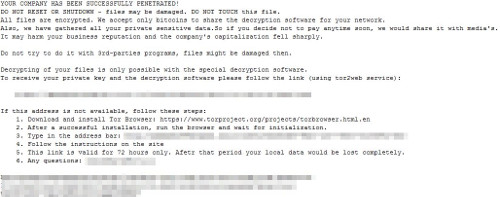RANSOM_ENTREPED.A
Trojan-FOCM!D2D21E4BE25B (McAfee); Gen:Variant.Zusy.257378 (Bitdefender); ML.Attribute.HighConfidence (Symantec)
Windows


Threat Type: Ransomware
Destructiveness: No
Encrypted: No
In the wild: Yes
OVERVIEW
This Ransomware executes then deletes itself afterward.
It modifies the Internet Explorer Zone Settings.
It encrypts files found in specific folders. It drops files as ransom note.
TECHNICAL DETAILS
94,208 bytes
EXE
No
14 Sep 2017
Encrypts files
Installation
This Ransomware drops a copy of itself in the following folders using different file names:
- %AppDataLocal%\{Random 1}\{Random 2}.exe
(Note: %AppDataLocal% is the Application Data folder found in Local Settings, where it is usually C:\Documents and Settings\{user name}\Local Settings\Application Data on Windows 2000, Windows Server 2003, and Windows XP (32- and 64-bit); C:\Users\{user name}\AppData\Local on Windows Vista (32- and 64-bit), Windows 7 (32- and 64-bit), Windows 8 (32- and 64-bit), Windows 8.1 (32- and 64-bit), Windows Server 2008, and Windows Server 2012.)
It drops the following copies of itself into the affected system and executes them:
- %AppDataLocal%\{Random 3}\{Random 4}.exe
(Note: %AppDataLocal% is the Application Data folder found in Local Settings, where it is usually C:\Documents and Settings\{user name}\Local Settings\Application Data on Windows 2000, Windows Server 2003, and Windows XP (32- and 64-bit); C:\Users\{user name}\AppData\Local on Windows Vista (32- and 64-bit), Windows 7 (32- and 64-bit), Windows 8 (32- and 64-bit), Windows 8.1 (32- and 64-bit), Windows Server 2008, and Windows Server 2012.)
It drops and executes the following files:
- %AppDataLocal%\{Random 5}:exe -> used to run net.exe
- %AppDataLocal%\{Random 6}:exe -> used to run vssadmin.exe
(Note: %AppDataLocal% is the Application Data folder found in Local Settings, where it is usually C:\Documents and Settings\{user name}\Local Settings\Application Data on Windows 2000, Windows Server 2003, and Windows XP (32- and 64-bit); C:\Users\{user name}\AppData\Local on Windows Vista (32- and 64-bit), Windows 7 (32- and 64-bit), Windows 8 (32- and 64-bit), Windows 8.1 (32- and 64-bit), Windows Server 2008, and Windows Server 2012.)
It adds the following processes:
- %System%\net.exe view
- %System%\net.exe view \{Computer Name}
- %System%\vssadmin.exe Delete Shadows /All /Quiet
(Note: %System% is the Windows system folder, where it usually is C:\Windows\System32 on all Windows operating system versions.)
It executes then deletes itself afterward.
Autostart Technique
This Ransomware adds the following registry entries to enable its automatic execution at every system startup:
HKEY_CURRENT_USER\Software\Microsoft\
Windows\CurrentVersion\Run
{Random Characters} = "%AppDataLocal%\{Random 1}\{Random 2}.exe"
Other System Modifications
This Ransomware deletes the following folders:
- {Malware Path}\
Web Browser Home Page and Search Page Modification
This Ransomware modifies the Internet Explorer Zone Settings.
Ransomware Routine
This Ransomware encrypts files found in the following folders:
- %System Root%
- %Program Files%
- All Drives
(Note: %System Root% is the Windows root folder, where it usually is C:\ on all Windows operating system versions.. %Program Files% is the Program Files folder, where it usually is C:\Program Files on all Windows operating system versions; C:\Program Files (x86) for 32-bit applications running on Windows 64-bit operating systems.)
It avoids encrypting files with the following strings in their file name:
- System Volume Information
- $RECYCLE.BIN
- WebCache
- Caches
- svsho*.exe
- schre*.bat
- V01.lo*
- V01.ch*
- V01res*.jrs
- RacWmi*.sdf
- Web*V01.dat
- svsho*.exe
- *.locked
- *.readme_txt
It avoids encrypting files found in the following folders:
- %ProgramData%\Microsoft\Windows\WER\ReportQueue\
- %Windows%\
- %User Temp%\
(Note: %ProgramData% is the Program Data folder, where it usually is C:\Program Files in Windows 2000, Windows Server 2003, and Windows XP (32- and 64-bit); C:\ProgramData in Windows Vista (32- and 64-bit), Windows 7 (32- and 64-bit), Windows 8 (32- and 64-bit), Windows 8.1 (32- and 64-bit), Windows Server 2008, and Windows Server 2012.. %Windows% is the Windows folder, where it usually is C:\Windows on all Windows operating system versions.. %User Temp% is the user's temporary folder, where it usually is C:\Documents and Settings\{user name}\Local Settings\Temp on Windows 2000, Windows Server 2003, and Windows XP (32- and 64-bit); C:\Users\{user name}\AppData\Local\Temp on Windows Vista (32- and 64-bit), Windows 7 (32- and 64-bit), Windows 8 (32- and 64-bit), Windows 8.1 (32- and 64-bit), Windows Server 2008, and Windows Server 2012.)
It appends the following extension to the file name of the encrypted files:
- .locked
It drops the following file(s) as ransom note:
- {Encrypted File Path}\{Encrypted File}.readme_txt
It leaves text files that serve as ransom notes containing the following text:
SOLUTION
9.850
13.660.01
14 Sep 2017
13.661.00
15 Sep 2017
Step 1
Before doing any scans, Windows XP, Windows Vista, and Windows 7 users must disable System Restore to allow full scanning of their computers.
Step 2
Note that not all files, folders, and registry keys and entries are installed on your computer during this malware's/spyware's/grayware's execution. This may be due to incomplete installation or other operating system conditions. If you do not find the same files/folders/registry information, please proceed to the next step.
Step 3
Delete this registry value
Important: Editing the Windows Registry incorrectly can lead to irreversible system malfunction. Please do this step only if you know how or you can ask assistance from your system administrator. Else, check this Microsoft article first before modifying your computer's registry.
- In HKEY_CURRENT_USER\Software\Microsoft\Windows\CurrentVersion\Run
- {Random Characters} = "%AppDataLocal%\{Random 1}\{Random 2}.exe"
- {Random Characters} = "%AppDataLocal%\{Random 1}\{Random 2}.exe"
Step 4
Search and delete these files
- %AppDataLocal%\{Random 5}:exe
- %AppDataLocal%\{Random 6}:exe
- {Encrypted File Path}\{Encrypted File}.readme_txt
Step 5
Scan your computer with your Trend Micro product to delete files detected as RANSOM_ENTREPED.A. If the detected files have already been cleaned, deleted, or quarantined by your Trend Micro product, no further step is required. You may opt to simply delete the quarantined files. Please check this Knowledge Base page for more information.
Step 6
Restore this file from backup only Microsoft-related files will be restored. If this malware/grayware also deleted files related to programs that are not from Microsoft, please reinstall those programs on you computer again.
Did this description help? Tell us how we did.


